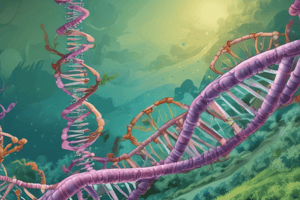Podcast
Questions and Answers
What does recombinant DNA technology allow molecular biologists to create?
What does recombinant DNA technology allow molecular biologists to create?
Novel DNA molecules that do not exist in nature
Who developed the basic tools for recombinant DNA technology?
Who developed the basic tools for recombinant DNA technology?
Stanly Cohen and Herbert Boyer
What was the first important contribution of recombinant DNA technology to medicine made by Genentech?
What was the first important contribution of recombinant DNA technology to medicine made by Genentech?
Cloning the human insulin gene
What is the recombinant human insulin approved by the FDA in 1982 commonly known as?
What is the recombinant human insulin approved by the FDA in 1982 commonly known as?
In recombinant DNA technology, what is the role of the vector?
In recombinant DNA technology, what is the role of the vector?
Which section of the DNA is often targeted for sequencing to determine the taxonomic identity of bacteria?
Which section of the DNA is often targeted for sequencing to determine the taxonomic identity of bacteria?
What is the primary goal of recovering the recombinant plasmid from the bacterial host?
What is the primary goal of recovering the recombinant plasmid from the bacterial host?
What significant environmental issue is being addressed in the Sacramento River Science Project?
What significant environmental issue is being addressed in the Sacramento River Science Project?
What are some contaminants that affect the water quality of the Sacramento River?
What are some contaminants that affect the water quality of the Sacramento River?
What does it mean to 'clone' a 16s rRNA gene fragment in this context?
What does it mean to 'clone' a 16s rRNA gene fragment in this context?
Study Notes
Overview of Recombinant DNA Technology
- Recombinant DNA technology enables creation of novel DNA molecules for research and therapy.
- Key tools include bacterial plasmid vectors, restriction enzymes, and ligases.
- Developed by Stanley Cohen and Herbert Boyer in the 1970s, leading to significant advancements in biotechnology.
Historical Milestones
- Genentech, co-founded by Boyer, was the first company to harness recombinant DNA technology.
- In 1978, Genentech cloned the human insulin gene into a bacterial plasmid, enabling production in E. coli.
- This innovation vastly improved diabetes treatment, replacing laborious insulin extraction from animal pancreases.
- Humulin became the first recombinant DNA product approved by the FDA in 1982.
Process of Creating Recombinant DNA
- The DNA vector is manipulated in vitro to insert foreign DNA.
- Introduced into bacteria, the recombinant plasmid replicates and produces proteins like insulin.
- Desired outcomes include recovering the recombinant plasmid for further analysis, often through DNA sequencing.
Environmental Context and Research Focus
- The 16s ribosomal RNA gene is utilized for determining bacterial taxonomy.
- The Sacramento River, California's largest watershed, faces contamination from urban and agricultural runoff.
- Contaminants include pesticides, methylmercury, antibiotics, and pathogens, affecting water quality.
Importance of Microbial Diversity
- Understanding microbes is critical for assessing water quality and environmental health.
- Microbes can both contaminate and detoxify pollutants, highlighting their dual role.
- Monitoring microbial populations helps indicate the health of the watershed.
Project Goals
- The project aims to clone the 16s rRNA gene fragment previously amplified in Biology lab courses.
- Cloning refers to inserting PCR fragments into vectors and obtaining recombinant plasmids from bacterial colonies derived from a single ancestor.
Studying That Suits You
Use AI to generate personalized quizzes and flashcards to suit your learning preferences.
Description
This quiz covers the fundamentals of recombinant DNA technology, a revolutionary technique that enables the creation of novel DNA molecules. Learn about the key tools used in this field such as bacterial plasmid vectors, restriction enzymes, and ligases, developed by pioneers like Stanley Cohen and Herbert Boyer.




